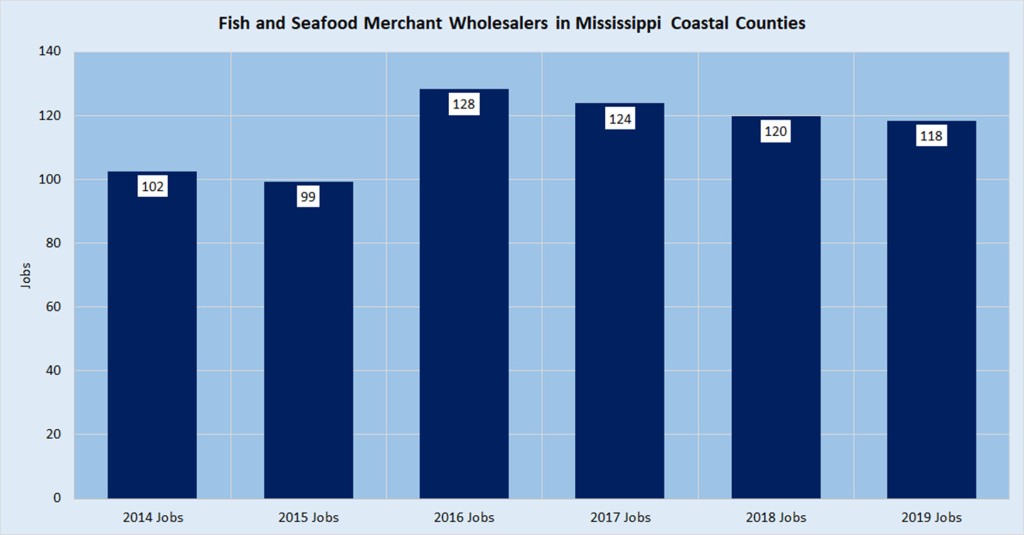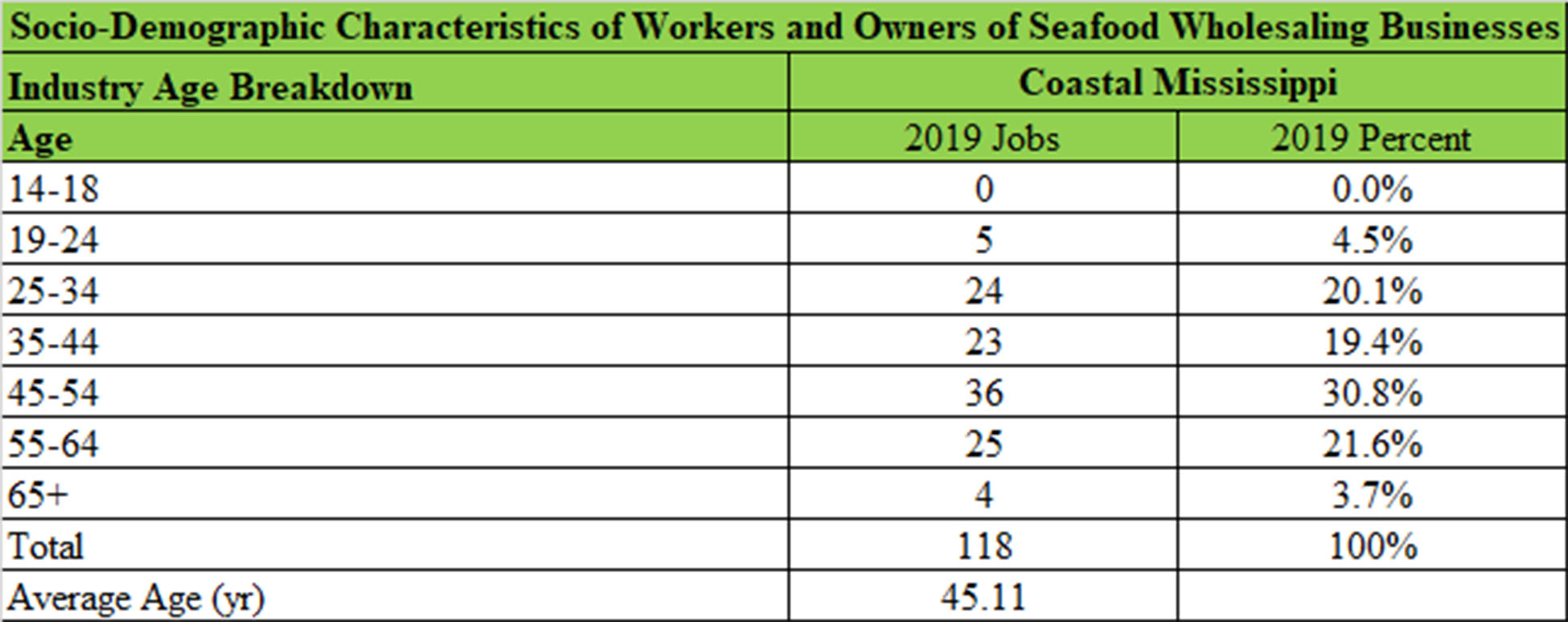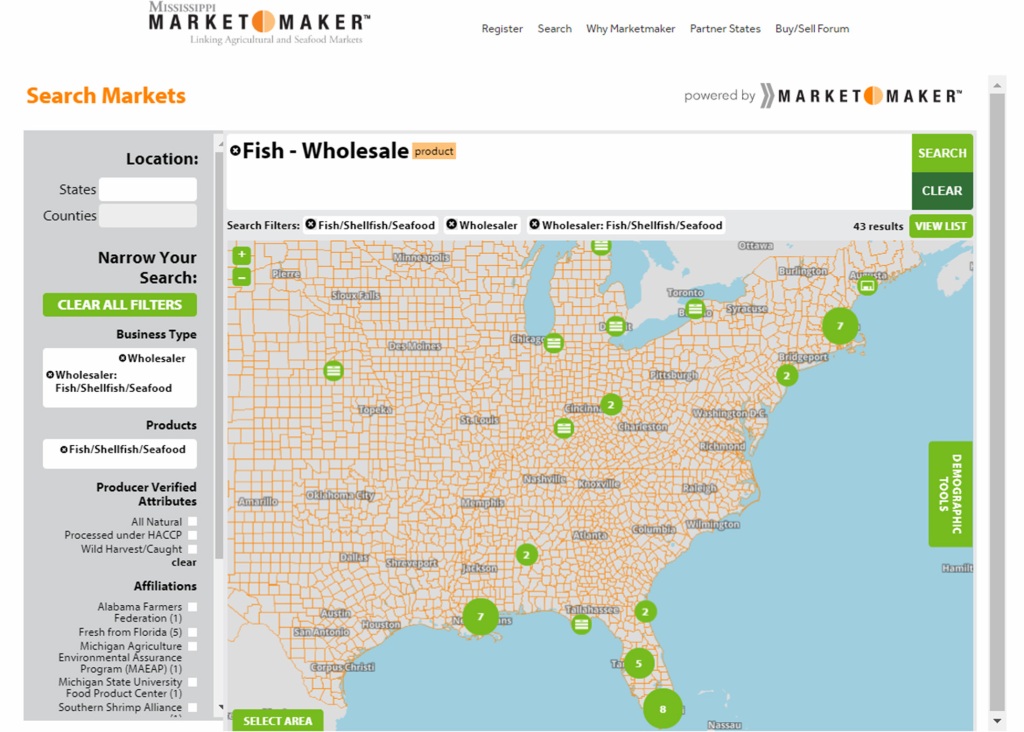Economic Contribution of Fish and Seafood Merchant Wholesalers in Mississippi Gulf Coast
In this issue, Dr. Posadas describes the economic contribution of the fish and seafood merchant wholesalersoperating in Coastal Mississippi. The Coastal Mississippi Region consists of three counties, namely: Hancock, Harrison, and JacksonCounties. The fish and seafood merchant wholesalers contributed $9.2 million to the gross regional product of Coastal Mississippi. These wholesale seafood markets were threatened by the lingering impacts of the man-made disaster associated with the prolonged and twice opening of the Bonnet Carre spillway from February to April and May to July 2019. The extent of the economic impacts of the man-made disaster to the wholesale seafood markets of Coastal Mississippi will take some time to assess. Instead, some benchmark data about the retail markets during the past five years are presented.
Employment and Wages, Salaries, and Earnings
Fish and seafood merchant wholesalers (NAICS 424460) include establishments primarily engaged in the merchant wholesale distribution of fish and seafood (except canned or packaged frozen). The industry directly hired an increasing number of employees from 102 jobs in 2014 to 128 jobs in 2016 in the three Coastal Mississippi Counties. However, the number of jobs directly created by the industry started to decline in 2017 and fell to 118 jobs in 2019 (Fig. 1).
The combined wages, salaries, and proprietor earnings of all the QCEW employees, non-QCEW employees, self-employed, and extended proprietors in the three Coastal Mississippi Counties continued to rise during the past five years (Fig. 2). Higher combined wages, salaries, and proprietor earnings exceeding $41,000 were estimated in 2018.
 Figure 1. Annual Employment of QCEW Employees, Non-QCEW Employees, Self-Employed, and Extended Proprietors. U.S. Bureau of Labor Statistics,Quarterly Census of Employment and Wages (EMSI, 2019).
Figure 1. Annual Employment of QCEW Employees, Non-QCEW Employees, Self-Employed, and Extended Proprietors. U.S. Bureau of Labor Statistics,Quarterly Census of Employment and Wages (EMSI, 2019). Figure 2. Average Earnings of QCEW Employees, Non-QCEW Employees, Self-Employed, and Extended Proprietors. U.S. Bureau of Labor Statistics,Quarterly Census of Employment and Wages (EMSI, 2019).
Figure 2. Average Earnings of QCEW Employees, Non-QCEW Employees, Self-Employed, and Extended Proprietors. U.S. Bureau of Labor Statistics,Quarterly Census of Employment and Wages (EMSI, 2019).
Distribution of Workers by Gender
The 2019 industrial overview released by EMSI (2019) showed that among workers and owners in the three Coastal Mississippi Counties, 83 percent were male (Fig. 3). About 17 percent of the workers and owners were female.
 Figure 3. Distribution of QCEW Employees, Non-QCEW Employees, Self-Employed, and Extended Proprietors by Gender. U.S. Bureau of Labor Statistics, Quarterly Census of Employment and Wages (EMSI, 2019).
Figure 3. Distribution of QCEW Employees, Non-QCEW Employees, Self-Employed, and Extended Proprietors by Gender. U.S. Bureau of Labor Statistics, Quarterly Census of Employment and Wages (EMSI, 2019).
Distribution of Workers by Age
The 2019 industrial overview released by EMSI (2019) showed that workers and owners in the three Coastal Mississippi Counties are relatively young, averaging 45 years old (Fig. 4). More than one-fourth of the workers and owners are 55 years old and above. The 45-55 years old workers and owners added 31 percent of the total. Over 19 percent belonged to the 35-44 years old age group. More than 24 percent of the workers and owners are below 35 years old.

Figure 4. Distribution of QCEW Employees, Non-QCEW Employees, Self-Employed, and Extended Proprietors by Age Group. U.S. Bureau of Labor Statistics, Quarterly Census of Employment and Wages (EMSI, 2019).
Distribution of Workers by Race or Ethnicity
The newly released industrial overview (EMSI, 2019) also sorted workers and owners by race or ethnicity (Fig. 5). The majority of the workers are White (75%), followed by Black or African American (15%). The remaining workers and owners are Hispanic or Latino (6%), Asian (4%), and two or more races (0.8%).
 Figure 5. Distribution of QCEW Employees, Non-QCEW Employees, Self-Employed, and Extended Proprietors by Race or Ethnicity. U.S. Bureau of Labor Statistics, Quarterly Census of Employment and Wages (EMSI, 2019).
Figure 5. Distribution of QCEW Employees, Non-QCEW Employees, Self-Employed, and Extended Proprietors by Race or Ethnicity. U.S. Bureau of Labor Statistics, Quarterly Census of Employment and Wages (EMSI, 2019).
Seafood Businesses Registered in MarketMaker
If you need an online database of local fish and seafood wholesalers, you may use the search tool in Mississippi MarketMaker or other state MarketMaker programs. There are 43 “fish/shellfish/seafood wholesalers” in the United States which registered their business profiles in MarketMaker. The Mississippi Department of Marine Resources website listed 22 seafood wholesalers in Mississippi (MDMR, 2019).
Gross Regional Product
 Figure 6. Map of the Locations of Fish and Seafood Wholesalers in the United States (Mississippi MarketMaker, 2019).
Figure 6. Map of the Locations of Fish and Seafood Wholesalers in the United States (Mississippi MarketMaker, 2019).
The Bureau of Economic Analysis (2019) defines the gross domestic product (GDP) as the value of the goods and services produced in the United States. The gross regional product (GRP) is simply the GDP for the region of study. EMSI (2019) measures the GRP as the sum of total industry earnings, taxes on production and imports, and profits, less subsidies.
The gross regional product (GRP) in the three coastal counties generated by fish and seafood wholesalers was estimated at $9.252 million in 2018 (EMSI, 2019). The bulk of the GRP consisted of earnings (63%), followed by taxes (4%), and property income (33%).
Disaster Implications
To save lives, properties, and the way of life in New Orleans and surrounding communities, the Bonnet Carre spillway was opened to release floodwater into Lake Pontchartrain and eventually into the Mississippi Sound. The livelihoods and way of life of the seafood businesses and surrounding communities dependent on coastal tourism and the seafood industry are threatened by lingering effects of the man-made disaster associated with the prolonged and twice opening of the Bonnet Carre spillway since February to April and May to July 2019.
The massive volumes of freshwater which were dumped into the fertile fishery grounds of the Mississippi Sound brought with them harmful freshwater algae that bloomed all over the coast. Beaches were closed, and advisories were in place until Labor Day weekend and beyond. Massive losses in vital marine resources in Coastal Mississippi disrupted commercial and recreational fishing activities. The disruption of the local supply chains of seafood products adversely affected local seafood processing, wholesaling, retailing, and restaurant activities.
This man-made disaster is a negative externality that causes consumer and producer losses. Market forces cannot create a system of payments for the offended parties. The government needs to intervene and compensate for the losses suffered by consumers and producers. The effects of the disaster confronting the Mississippi Sound will linger for some time, and the economic hardships will further erode the quality of life of coastal households, businesses, and communities.
Suggested Citation:
Posadas, Benedict C. Mississippi MarketMaker Newsletter, Vol. 9, No. 12. December 3, 2019. http://extension.msstate.edu/newsletters/mississippi-marketmaker.
